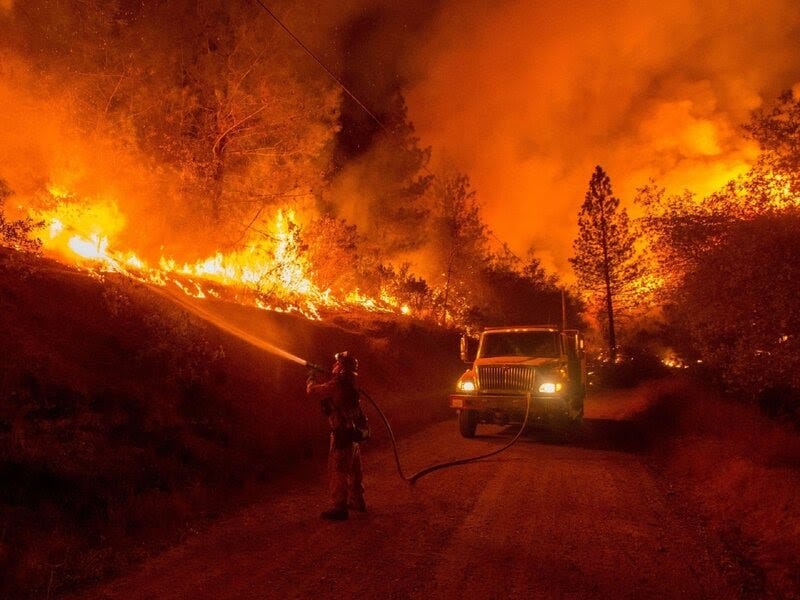
Welcome to the third and final edition of our special column series. Next week, we’ll be back to our normal coverage of financial markets and business news. Like what you see? Share and subscribe!
Over the last few weeks we have laid out two of the “Big 3” forces we believe are shaping the world economy today:
A falling rate of profit, offset with rapidly accumulating debt suppressing future growth
An upheaval in the world order led by China’s rise
Today we lay out the third: climate change. Climate change threatens the global financial order by upsetting global commodity prices, not only through ecological impacts, but more importantly through the necessary steps we will take to try and minimize the impacts. Alongside the other two forces we’ve explored, we anticipate that even successful climate change mitigation will throw the world economic system into major turmoil.
All the world’s political systems have failed to prevent this long-predicted ecological catastrophe. The Intergovernmental Panel on Climate Change (IPCC) said in its latest report in 2018 that “global warming is likely to reach” 1.5 degrees celsius by the middle of this century, with impacts lasting for centuries to come. They and other experts believe that warming substantially above this level -- over two degrees celsius -- could have catastrophic consequences humans and other species cannot adapt to.
Yet just last month the U.N. Environment Programme reported that even with the unprecedented dip in emissions caused by pandemic shutdowns, the world is still on pace for 3 degrees of warming by 2100. The Global Carbon Project now says that the world’s industries have already burned through 92% of the “carbon budget” allotted to them to keep warming at or under 1.5 degrees. The “disproportionately rapid evacuation from the tropics” and mass extinctions prophesied by the IPCC now look unavoidable, perhaps as soon as the next 15 years.
But what about the climate commitments we keep hearing about from business and governments? These face two huge problems. First, they require a rapid transition from our present energy mix to carbon-free alternatives, costing a minimum of $30-40 trillion. Renewable sources require up to five times the capital outlay per unit of energy generated when compared to fossil fuels. Our first “Big 3” phenomenon -- falling rates of profit -- only makes this transition harder.
But this is the cheap half of the problem: the second obstacle is the need to remove carbon from the atmosphere -- transition isn’t enough. A 2017 paper led by climate science icon James Hansen estimated that this process will cost between $89 and 535 trillion. That bears repeating: it could cost up to half a quadrillion dollars.
It’s here that even deeper financial risks arise. Bioenergy crops, carbon sink forests, and other land use changes will mean using potentially millions of square kilometers of agricultural land for new purposes. This will crowd out food and other primary commodity crops, raising prices. Some climate models put the price increases as high as 82% in Sub-Saharan Africa and 73% in Latin America, with water costs increasing as much as 460% as climate crops consume irrigation resources.
This is a big problem. Monetary systems have to maintain a stable relationship between the value of their currencies and the prices of commodities, especially primary commodities. Price instability threatens the value of the currency and therefore the entire monetary order. Four of the last five global recessions (before last year’s pandemic crisis) began with oil price shocks, with resulting price instability sparking financial crises.
So not only does business have to move its capital into less productive investments, it has to raise input costs overall for the entire world economy, risking new financial crises even while profit rates are falling anyways. The world’s economic leadership may have to stabilize currency values by switching back to a hard currency basis -- causing massive global deflation -- or renegotiate the financial system altogether.
Our second “Big 3” force makes U.S.-China collaboration in this process increasingly unlikely, while the abject disaster of U.S. leadership in the COVID crisis makes a U.S.-led solution hard to imagine. Much more likely in this context: great power mischief-making in the wake of climate-related crises, a la the Syrian Civil War. But this too risks feeding into price volatility, setting a feedback loop into motion and raising the stakes even further.
This, by the way, is the best case scenario. One way or the other we have no chance of escaping heightened danger for the rest of this century at least. Along with rising international conflict between contending economic systems and an inexorable crisis in the world’s leading economies, our way of life is headed toward a permanent rupture.
Follow us as we watch the business pages to see how it all unfolds in real time.
Disclaimer
Our only investment advice: Keep an eye on the Suns.
Contact us with feedback, questions, or stories we might have missed.


